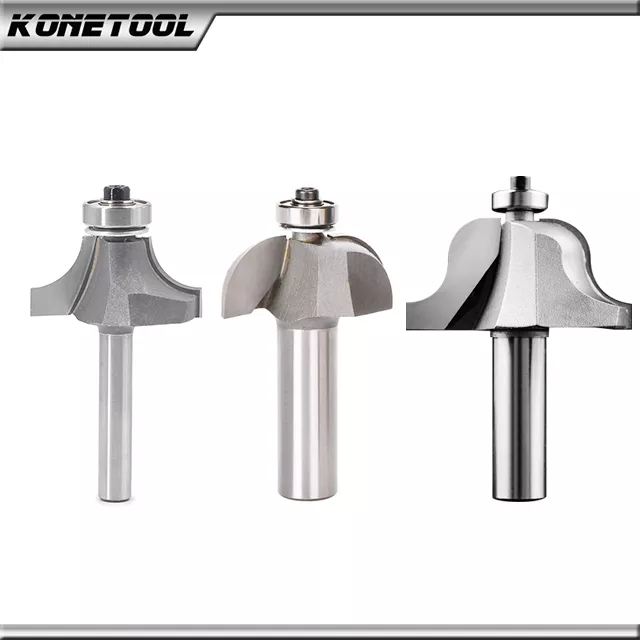
Router bits are cutting tools that are used in woodworking to shape, cut, and create decorative edges on wood, plastic, and other materials. They come in a variety of shapes and sizes and are designed to be used with a router, which is a power tool that spins the bit at high speeds. In this article, we will discuss the key features and considerations when it comes to router bits.
1. Material
Router bits can be made from a variety of materials, including high-speed steel (HSS), carbide, and diamond. HSS bits are the most affordable but are not as durable as carbide or diamond. Carbide bits are the most popular due to their durability and versatility. They can be used for a wide range of applications and are suitable for both handheld and table-mounted routers. Diamond bits are the most expensive but are the most durable and can be used for cutting hard materials like glass and stone.
2. Shape
Router bits come in a variety of shapes, each with its own specific use. Some of the most common shapes include:
– Straight Bits: These bits have a straight cutting edge and are used for making straight cuts, grooves, and slots.
– Roundover Bits: These bits have a curved cutting edge and are used to create rounded edges on wood.
– Cove Bits: These bits have a concave cutting edge and are used to create decorative edges on wood.
– Chamfer Bits: These bits have a angled cutting edge and are used to create beveled edges on wood.
– Rabbeting Bits: These bits have a straight cutting edge and a guide bearing that allows them to cut a groove along the edge of a board.
– Flush Trim Bits: These bits have a guide bearing that allows them to follow the contour of a template or pattern to create an exact duplicate of the pattern.
– Dovetail Bits: These bits have a tapered cutting edge and are used to create dovetail joints, which are commonly used in furniture and cabinetry.
– V-Groove Bits: These bits have a V-shaped cutting edge and are used to create decorative grooves in wood.
3. Size
Router bits come in a range of sizes, and it’s important to choose the right size for the job. The size of the bit will depend on the depth and width of the cut that you need to make. For example, a 1/4-inch straight bit is suitable for making shallow cuts, while a 1/2-inch straight bit is suitable for making deeper cuts. It’s also important to choose a bit that is compatible with your router, as some routers only accept certain sizes of bits.
4. Shank Size
The shank size of the router bit is also an important consideration. The shank is the part of the bit that fits into the collet of the router. The most common shank sizes are 1/4 inch and 1/2 inch. A 1/4-inch shank is suitable forlight-duty work and is compatible with most handheld routers, while a 1/2-inch shank is suitable for heavy-duty work and is compatible with larger, table-mounted routers.
5. Cutting Depth
The cutting depth of the router bit is another important consideration. The cutting depth refers to the depth of the cut that the bit can make. Some bits are designed for shallow cuts, while others are designed for deeper cuts. It’s important to choose a bit with a cutting depth that is suitable for the job you need to do.
6. Quality
The quality of the router bit is also an important consideration. Higher quality bits are made from better materials and are designed to last longer and provide better performance. Cheaper bits may be made from inferior materials and may not last as long or provide the same level of performance.
7. Coating
Some router bits may have a coating that is designed to reduce friction and increase the lifespan of the bit. Coatings can be made from a variety of materials, including titanium, carbide, and diamond. Coated bits are usually more expensive than uncoated bits, but they offer better performance and durability.
8. Maintenance
Proper maintenance is important for prolonging the lifespan of your router bits. After use, it’s important to clean the bits and remove any debris that may have accumulated. It’s also important to sharpen the bits regularly to maintain their cutting performance. Some bits may be sharpened using a sharpening stone or file, whileothers may need to be sent to a professional for sharpening.
9. Safety
Safety is always a top priority when working with power tools like routers and router bits. It’s important to always wear eye and ear protection when using a router. It’s also important to use the right bit for the job and to ensure that the bit is properly secured in the router. Always follow the manufacturer’s instructions and use caution when working with a router.
In conclusion, router bits are an essential tool for any woodworking project. When choosing a router bit, it’s important to consider the material, shape, size, shank size, cutting depth, quality, coating, maintenance, and safety. By choosing the right router bit for the job and taking proper care of it, you can ensure that your woodworking projects will be a success.